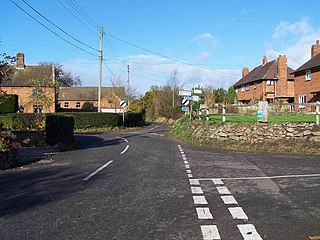Shelvock Manor is a house and grounds in a township of the same name near Shrewsbury, Shropshire, England. It was once a place of local importance, and was for more than two centuries the seat of the Thornes, a leading family in Shropshire. The first recorded spelling of Shelvock was Shelfhoc (1175), and later Sselvak and Schelfac. The name is most likely derived from the Saxon "ac" meaning oak, prefixed by its location on a shelf or hill.

Shifnal is a market town and civil parish in Shropshire, England, about 4 miles (6 km) east of Telford, 17 miles (27 km) east of Shrewsbury and 13 miles (20 km) west-northwest of Wolverhampton. It is near the M54 motorway and A5 road aka Watling Street. At the 2001 census, it had a population of 6,391, increasing to 6,776 at the 2011 census.

Weston Park is a country house in Weston-under-Lizard, Staffordshire, England, set in more than 1,000 acres (400 ha) of park landscaped by Capability Brown. The park is located 10 miles (16 km) north-west of Wolverhampton, and 8 miles (13 km) north-east of Telford, close to the border with Shropshire. The 17th-century Hall is a Grade I listed building and several other features of the estate, such as the Orangery and the Stable block, are separately listed as Grade II.

Loton Park is a country house near Alberbury, Shrewsbury in Shropshire, on the upper reaches of the River Severn. It is a Grade II* listed building. It has been the seat of the Leighton family since 1391.

Shrubland Hall, Coddenham, Suffolk, is a historic English country house with planned gardens in Suffolk, England, built in the 1770s.

Stanton upon Hine Heath is a village and parish in Shropshire, England. The River Roden flows through the village.
Blyth Hall is a privately owned mansion house on the banks of the River Blythe situated near Shustoke, Warwickshire. It is a Grade I listed building.

Whitmore Hall is the home of the Cavenagh-Mainwaring family at Whitmore, Staffordshire. A Grade I listed building, the hall was designated a house of outstanding architectural and historical interest and is a fine example of a small Carolean style manor house.
This is a list of sheriffs and high sheriffs of Shropshire

Matfen Hall is a 19th-century country mansion in Matfen, Northumberland, England, the seat of the Blackett baronets and now also a hotel and country golf club. It is a Grade II* listed building.

Sodington Hall is an early 19th-century country house in the parish of Mamble in Worcestershire, England. The Grade II listed building was described by Nikolaus Pevsner as "neat and modest" and by James Lees-Milne in the Shell Worcestershire Guide as a "red brick dolls house".

Kinlet Hall is an 18th-century, 33,609 square feet (3,122 m2) English country house at Kinlet, Shropshire, England, now occupied by an independent day and residential school. It is a Grade I listed building and its design was inspired by Villa Pisani, Montagnana.

Downton Hall is a privately owned 18th-century country house at Stanton Lacy, near Ludlow, Shropshire. It is a Grade II* listed building.

Osbaston Hall is a privately owned 18th-century country house at Osbaston, Leicestershire. It is the home of the de Lisle family and a Grade II* listed building.

Willey is a small village south west of the town of Broseley, Shropshire, England, within the civil parish of Barrow. It is made up of about 4 farms and the majority of land is owned and leased by the Weld-Forester family of Willey Hall. Willey also sports a proud cricket team like many small villages around the United Kingdom.
Sir John Corbet, 1st Baronet of Stoke upon Tern was an English politician who represented Shropshire in the House of Commons of the long Parliament. A moderate Puritan, he was noted before the English Civil War for his campaigns against extra-parliamentary taxation, which led to his imprisonment, and for waging a long running dispute over control of his parish church at Adderley. He was a notable member of the Shropshire county committee, responsible for pursuing the war against the royalists. Part of a Presbyterian middle group in Parliament, he was one of those secluded from parliament by Pride's Purge, and was stripped of his remaining public offices after the Restoration.
There have been two baronetcies created for persons with the surname Briggs, one in the Baronetage of England and one in the Baronetage of the United Kingdom. Both creations are extinct.

Henley Hall is a building of historical significance and is listed on the English Heritage Register. It was built in about 1610 by the Powys family and then substantially changed in 1772. Additions were again made in the late 19th century. It is a generally a three-storey building in brick with a slate roof. Flanking wings were added at both ends of the original linear building c. 1772 and further major extensions carried out in 1875 and 1907. The hall is surrounded by landscaped and formal gardens covering some 60 hectares. The hall itself is listed grade II* and the orangery, outbuildings, dovecote and Bitterley main gate are listed Grade II. It is situated 2.5 miles (4.0 km) northeast of Ludlow town centre, just off the A4117 road to Cleobury Mortimer. The Ledwyche Brook flows by the estate.

Madeley Court is a 16th-century country house in Madeley, Shropshire, England which was originally built as a grange to the medieval Wenlock Priory. It has since been restored as a hotel.

Aldenham Park, also known as Aldenham Hall, is a late 17th-century country house in Morville, near Bridgnorth, Shropshire, England which stands in 12 hectares of parkland. It is a Grade II* listed building.















